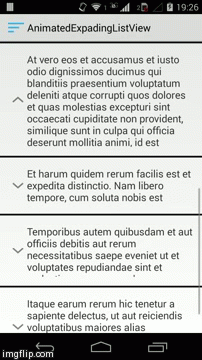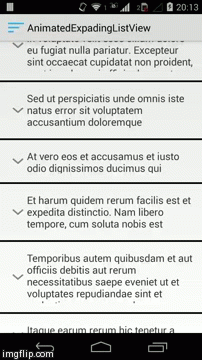How can I make a cell in a ListView in Android expand and contract vertically when it's touched?
I have a cell in a ListView that has a bunch of text in it. I show the first two rows of text and then end it with a \"...\" if it goes beyond. I want a user to be able to t
-
Here is an option that I would do:
Add an if statement to your ListView's BaseAdapter that will query your ListView for current selected items. If the current item you are drawing (in your BaseAdapter) is the selected item's position, then create your expanded view instead. Then resume normal view creation.
Edit:
I made this as an option under the assumption that you want to expand one (1) item at a time and not, say, an entire list.
讨论(0) -
Here is example from Udinic. It had listview item expand with animation and require API level only 4+
ExpandAnimationExample
in onItemClick event use ExpandAnimation
/** * This animation class is animating the expanding and reducing the size of a view. * The animation toggles between the Expand and Reduce, depending on the current state of the view * @author Udinic * */ public class ExpandAnimation extends Animation { private View mAnimatedView; private LayoutParams mViewLayoutParams; private int mMarginStart, mMarginEnd; private boolean mIsVisibleAfter = false; private boolean mWasEndedAlready = false; /** * Initialize the animation * @param view The layout we want to animate * @param duration The duration of the animation, in ms */ public ExpandAnimation(View view, int duration) { setDuration(duration); mAnimatedView = view; mViewLayoutParams = (LayoutParams) view.getLayoutParams(); // decide to show or hide the view mIsVisibleAfter = (view.getVisibility() == View.VISIBLE); mMarginStart = mViewLayoutParams.bottomMargin; mMarginEnd = (mMarginStart == 0 ? (0- view.getHeight()) : 0); view.setVisibility(View.VISIBLE); } @Override protected void applyTransformation(float interpolatedTime, Transformation t) { super.applyTransformation(interpolatedTime, t); if (interpolatedTime < 1.0f) { // Calculating the new bottom margin, and setting it mViewLayoutParams.bottomMargin = mMarginStart + (int) ((mMarginEnd - mMarginStart) * interpolatedTime); // Invalidating the layout, making us seeing the changes we made mAnimatedView.requestLayout(); // Making sure we didn't run the ending before (it happens!) } else if (!mWasEndedAlready) { mViewLayoutParams.bottomMargin = mMarginEnd; mAnimatedView.requestLayout(); if (mIsVisibleAfter) { mAnimatedView.setVisibility(View.GONE); } mWasEndedAlready = true; } } }Detail usage is in project.
讨论(0) -
I've never used ExpandableListViews, but I figure it's pretty simple to do a "manual" implementation of that. Extending an ArrayAdapter we can manipulate the row layout as we want. So, create your extended adapter, and two onClickListeners, one to expand, one to contract. I've pasted the whole class here.
If you don't want some of the items to be extendable just adjust the listeners to your needs. If you want it to look better you can add some sliding animation, but from here you should have enough to do whatever you need!
public class ExtendedAdapter extends BaseAdapter { public static final String TAG = "TodoAdapter"; private Context mContext; private int layoutResource; private List<String> items; private OnClickListener expand; private OnClickListener contract; public ExtendedAdapter(Context context, int textViewResourceId, List<String> items) { this.items = items; this.mContext = context; this.layoutResource = textViewResourceId; expand = new OnClickListener() { @Override public void onClick(View v) { TextView tv = (TextView) v; String[] textSplited = tv.getText().toString().split(" "); // somehow split your text tv.setMaxLines(textSplited.length); StringBuilder sb = new StringBuilder(); for (String word : textSplited) sb.append(word + "\n"); tv.setText(sb.toString()); tv.setOnClickListener(contract); } }; contract = new OnClickListener() { @Override public void onClick(View v) { TextView tv = (TextView) v; tv.setMaxLines(1); String[] textSplitted = tv.getText().toString().split("\n"); StringBuilder sb = new StringBuilder(); for (String word : textSplitted) sb.append(word + " "); tv.setText(sb.toString()); tv.setOnClickListener(expand); } }; } public int getCount() { return items.size(); } public Object getItem(int position) { return position; } public long getItemId(int position) { return position; } @Override public View getView(int position, View convertView, ViewGroup parent) { View v = convertView; if (v == null) { LayoutInflater vi = (LayoutInflater) mContext .getSystemService(Context.LAYOUT_INFLATER_SERVICE); v = vi.inflate(layoutResource, null); } TextView text = (TextView) v.findViewById(R.id.extended_text); text.setText(items.get(position)); text.setOnClickListener(expand); return v; } }And the row_layout.xml
<?xml version="1.0" encoding="utf-8"?> <LinearLayout xmlns:android="http://schemas.android.com/apk/res/android" android:paddingTop="4dip" android:paddingBottom="6dip" android:layout_width="fill_parent" android:layout_height="wrap_content" android:orientation="horizontal" android:textSize="13sp"> <TextView android:id="@+id/extended_text" android:layout_width="275dip" android:layout_height="wrap_content" android:maxLines="1" android:ellipsize="end"/> </LinearLayout>讨论(0) -
There is a sample in the SDK, it could help you.
It's called, obviously,
ExpandableList. Located in the API Demos (/docs/resources/samples/ApiDemos/src/com/example/android/apis/view)讨论(0) -
I've implemented a simple code that works in all Android's sdk versions.
See below its working and the code.
Github code: https://github.com/LeonardoCardoso/Animated-Expanding-ListView
For information on my website: http://android.leocardz.com/animated-expanding-listview/


Basically, you have to create a custom TranslateAnimation and a Custom List Adapter and, while it's animating, you have to update the current height of listview item and notify the adapter about this change.
Let's go to the code.
List Item layout
<?xml version="1.0" encoding="utf-8"?> <LinearLayout xmlns:android="http://schemas.android.com/apk/res/android" android:id="@+id/text_wrap" android:layout_width="match_parent" android:layout_height="wrap_content" android:orientation="horizontal" android:paddingBottom="@dimen/activity_vertical_margin" android:paddingLeft="@dimen/activity_horizontal_margin" android:paddingRight="@dimen/activity_horizontal_margin" android:paddingTop="@dimen/activity_vertical_margin" > <TextView android:id="@+id/text" android:layout_width="match_parent" android:layout_height="wrap_content" android:textSize="18sp" > </TextView> </LinearLayout>Activity Layout
<RelativeLayout xmlns:android="http://schemas.android.com/apk/res/android" xmlns:tools="http://schemas.android.com/tools" android:layout_width="match_parent" android:layout_height="match_parent" tools:context=".MainActivity" > <ListView android:id="@+id/list" android:layout_width="match_parent" android:layout_height="wrap_content" android:divider="@android:color/black" android:dividerHeight="3dp" > </ListView> </RelativeLayout>List Item class
public class ListItem { private String text; private int collapsedHeight, currentHeight, expandedHeight; private boolean isOpen; private ListViewHolder holder; private int drawable; public ListItem(String text, int collapsedHeight, int currentHeight, int expandedHeight) { super(); this.text = text; this.collapsedHeight = collapsedHeight; this.currentHeight = currentHeight; this.expandedHeight = expandedHeight; this.isOpen = false; this.drawable = R.drawable.down; } public String getText() { return text; } public void setText(String text) { this.text = text; } public int getCollapsedHeight() { return collapsedHeight; } public void setCollapsedHeight(int collapsedHeight) { this.collapsedHeight = collapsedHeight; } public int getCurrentHeight() { return currentHeight; } public void setCurrentHeight(int currentHeight) { this.currentHeight = currentHeight; } public int getExpandedHeight() { return expandedHeight; } public void setExpandedHeight(int expandedHeight) { this.expandedHeight = expandedHeight; } public boolean isOpen() { return isOpen; } public void setOpen(boolean isOpen) { this.isOpen = isOpen; } public ListViewHolder getHolder() { return holder; } public void setHolder(ListViewHolder holder) { this.holder = holder; } public int getDrawable() { return drawable; } public void setDrawable(int drawable) { this.drawable = drawable; } }View Holder class
public class ListViewHolder { private LinearLayout textViewWrap; private TextView textView; public ListViewHolder(LinearLayout textViewWrap, TextView textView) { super(); this.textViewWrap = textViewWrap; this.textView = textView; } public TextView getTextView() { return textView; } public void setTextView(TextView textView) { this.textView = textView; } public LinearLayout getTextViewWrap() { return textViewWrap; } public void setTextViewWrap(LinearLayout textViewWrap) { this.textViewWrap = textViewWrap; } }Custom Animation class
public class ResizeAnimation extends Animation { private View mView; private float mToHeight; private float mFromHeight; private float mToWidth; private float mFromWidth; private ListAdapter mListAdapter; private ListItem mListItem; public ResizeAnimation(ListAdapter listAdapter, ListItem listItem, float fromWidth, float fromHeight, float toWidth, float toHeight) { mToHeight = toHeight; mToWidth = toWidth; mFromHeight = fromHeight; mFromWidth = fromWidth; mView = listItem.getHolder().getTextViewWrap(); mListAdapter = listAdapter; mListItem = listItem; setDuration(200); } @Override protected void applyTransformation(float interpolatedTime, Transformation t) { float height = (mToHeight - mFromHeight) * interpolatedTime + mFromHeight; float width = (mToWidth - mFromWidth) * interpolatedTime + mFromWidth; LayoutParams p = (LayoutParams) mView.getLayoutParams(); p.height = (int) height; p.width = (int) width; mListItem.setCurrentHeight(p.height); mListAdapter.notifyDataSetChanged(); } }Custom List Adapter class
public class ListAdapter extends ArrayAdapter<ListItem> { private ArrayList<ListItem> listItems; private Context context; public ListAdapter(Context context, int textViewResourceId, ArrayList<ListItem> listItems) { super(context, textViewResourceId, listItems); this.listItems = listItems; this.context = context; } @Override @SuppressWarnings("deprecation") public View getView(int position, View convertView, ViewGroup parent) { ListViewHolder holder = null; ListItem listItem = listItems.get(position); if (convertView == null) { LayoutInflater vi = (LayoutInflater) context .getSystemService(Context.LAYOUT_INFLATER_SERVICE); convertView = vi.inflate(R.layout.list_item, null); LinearLayout textViewWrap = (LinearLayout) convertView .findViewById(R.id.text_wrap); TextView text = (TextView) convertView.findViewById(R.id.text); holder = new ListViewHolder(textViewWrap, text); } else holder = (ListViewHolder) convertView.getTag(); holder.getTextView().setText(listItem.getText()); LayoutParams layoutParams = new LayoutParams(LayoutParams.FILL_PARENT, listItem.getCurrentHeight()); holder.getTextViewWrap().setLayoutParams(layoutParams); holder.getTextView().setCompoundDrawablesWithIntrinsicBounds( listItem.getDrawable(), 0, 0, 0); convertView.setTag(holder); listItem.setHolder(holder); return convertView; } }Main Activity
public class MainActivity extends Activity { private ListView listView; private ArrayList<ListItem> listItems; private ListAdapter adapter; private final int COLLAPSED_HEIGHT_1 = 150, COLLAPSED_HEIGHT_2 = 200, COLLAPSED_HEIGHT_3 = 250; private final int EXPANDED_HEIGHT_1 = 250, EXPANDED_HEIGHT_2 = 300, EXPANDED_HEIGHT_3 = 350, EXPANDED_HEIGHT_4 = 400; private boolean accordion = true; @Override protected void onCreate(Bundle savedInstanceState) { super.onCreate(savedInstanceState); setContentView(R.layout.activity_main); listView = (ListView) findViewById(R.id.list); listItems = new ArrayList<ListItem>(); mockItems(); adapter = new ListAdapter(this, R.layout.list_item, listItems); listView.setAdapter(adapter); listView.setOnItemClickListener(new OnItemClickListener() { @Override public void onItemClick(AdapterView<?> parent, View view, int position, long id) { toggle(view, position); } }); } private void toggle(View view, final int position) { ListItem listItem = listItems.get(position); listItem.getHolder().setTextViewWrap((LinearLayout) view); int fromHeight = 0; int toHeight = 0; if (listItem.isOpen()) { fromHeight = listItem.getExpandedHeight(); toHeight = listItem.getCollapsedHeight(); } else { fromHeight = listItem.getCollapsedHeight(); toHeight = listItem.getExpandedHeight(); // This closes all item before the selected one opens if (accordion) { closeAll(); } } toggleAnimation(listItem, position, fromHeight, toHeight, true); } private void closeAll() { int i = 0; for (ListItem listItem : listItems) { if (listItem.isOpen()) { toggleAnimation(listItem, i, listItem.getExpandedHeight(), listItem.getCollapsedHeight(), false); } i++; } } private void toggleAnimation(final ListItem listItem, final int position, final int fromHeight, final int toHeight, final boolean goToItem) { ResizeAnimation resizeAnimation = new ResizeAnimation(adapter, listItem, 0, fromHeight, 0, toHeight); resizeAnimation.setAnimationListener(new AnimationListener() { @Override public void onAnimationStart(Animation animation) { } @Override public void onAnimationRepeat(Animation animation) { } @Override public void onAnimationEnd(Animation animation) { listItem.setOpen(!listItem.isOpen()); listItem.setDrawable(listItem.isOpen() ? R.drawable.up : R.drawable.down); listItem.setCurrentHeight(toHeight); adapter.notifyDataSetChanged(); if (goToItem) goToItem(position); } }); listItem.getHolder().getTextViewWrap().startAnimation(resizeAnimation); } private void goToItem(final int position) { listView.post(new Runnable() { @Override public void run() { try { listView.smoothScrollToPosition(position); } catch (Exception e) { listView.setSelection(position); } } }); } private void mockItems() { listItems .add(new ListItem( "Lorem ipsum dolor sit amet, consectetur adipisicing elit, sed do eiusmod tempor incididunt ut labore et dolore magna aliqua.", COLLAPSED_HEIGHT_1, COLLAPSED_HEIGHT_1, EXPANDED_HEIGHT_1)); listItems .add(new ListItem( "Ut enim ad minim veniam, quis nostrud exercitation ullamco laboris nisi ut aliquip ex ea commodo consequat.", COLLAPSED_HEIGHT_2, COLLAPSED_HEIGHT_2, EXPANDED_HEIGHT_2)); listItems .add(new ListItem( "Duis aute irure dolor in reprehenderit in voluptate velit esse cillum dolore eu fugiat nulla pariatur. Excepteur sint occaecat cupidatat non proident, sunt in culpa qui officia deserunt mollit anim id est laborum.", COLLAPSED_HEIGHT_3, COLLAPSED_HEIGHT_3, EXPANDED_HEIGHT_3)); listItems .add(new ListItem( "Sed ut perspiciatis unde omnis iste natus error sit voluptatem accusantium doloremque laudantium, totam rem aperiam, eaque ipsa quae ab illo inventore veritatis et quasi architecto beatae vitae dicta sunt explicabo.", COLLAPSED_HEIGHT_2, COLLAPSED_HEIGHT_2, EXPANDED_HEIGHT_4)); listItems .add(new ListItem( "At vero eos et accusamus et iusto odio dignissimos ducimus qui blanditiis praesentium voluptatum deleniti atque corrupti quos dolores et quas molestias excepturi sint occaecati cupiditate non provident, similique sunt in culpa qui officia deserunt mollitia animi, id est laborum et dolorum fuga.", COLLAPSED_HEIGHT_1, COLLAPSED_HEIGHT_1, EXPANDED_HEIGHT_4)); listItems .add(new ListItem( "Et harum quidem rerum facilis est et expedita distinctio. Nam libero tempore, cum soluta nobis est eligendi optio cumque nihil impedit quo minus id quod maxime placeat facere possimus, omnis voluptas assumenda est, omnis dolor repellendus.", COLLAPSED_HEIGHT_2, COLLAPSED_HEIGHT_2, EXPANDED_HEIGHT_4)); listItems .add(new ListItem( "Temporibus autem quibusdam et aut officiis debitis aut rerum necessitatibus saepe eveniet ut et voluptates repudiandae sint et molestiae non recusandae.", COLLAPSED_HEIGHT_3, COLLAPSED_HEIGHT_3, EXPANDED_HEIGHT_3)); listItems .add(new ListItem( "Itaque earum rerum hic tenetur a sapiente delectus, ut aut reiciendis voluptatibus maiores alias consequatur aut perferendis doloribus asperiores repellat.", COLLAPSED_HEIGHT_1, COLLAPSED_HEIGHT_1, EXPANDED_HEIGHT_4)); } }
讨论(0) -
What you want to do is have a flag that knows if the row is expanded or not. If it is, then run an animation that shrinks it, and vice versa.
public void onListItemClicked(int position) { View v = listView.getView(position); if(expanded[position]) v.startAnimation(shrinkAnimation); else v.startAnimation(growAnimation); expanded[position] = !expanded[position]; }Simple.
However if what you are doing is something similar to the screen shot you implemented, I would advise against doing this with a ListView. The views are each different enough to warrant just doing this manually with
LinearLayouts. Only use the ListView if the number of rows is unknown or very large.讨论(0)
- 热议问题

 加载中...
加载中...